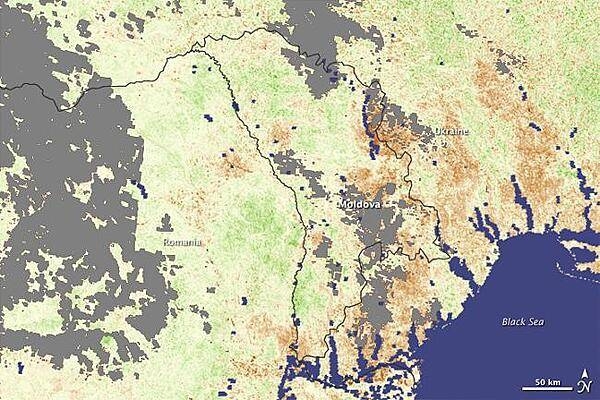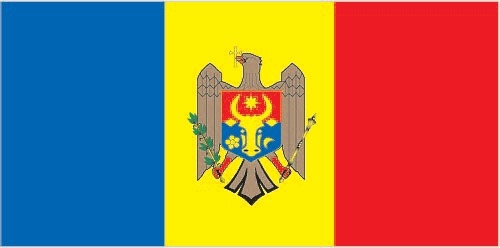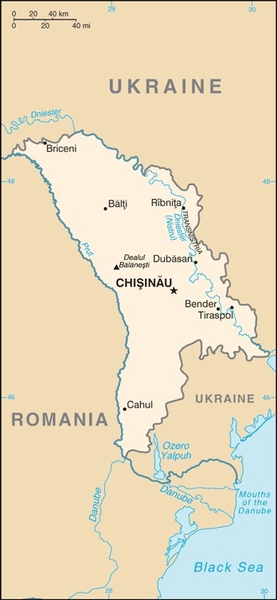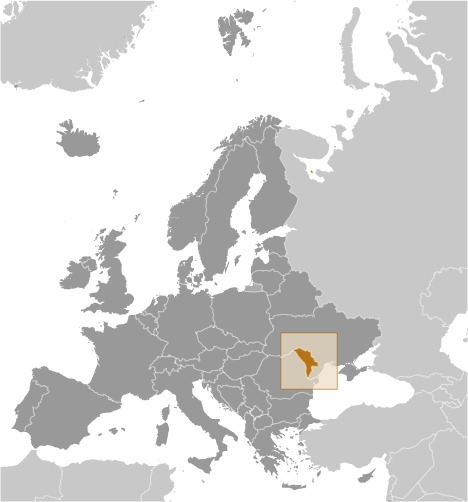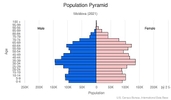Moldova
Introduction
Background
A large portion of present day Moldovan territory became a province of the Russian Empire in 1812 and then unified with Romania in 1918 in the aftermath of World War I. This territory was then incorporated into the Soviet Union at the close of World War II. Although Moldova has been independent from the Soviet Union since 1991, Russian forces have remained on Moldovan territory east of the Nistru River in the breakaway region of Transnistria.
Years of Communist Party rule in Moldova from 2001-09 ultimately ended with election-related violent protests and a rerun of parliamentary elections in 2009. A series of pro-Europe ruling coalitions governed Moldova from 2010-19, but pro-Russia Igor DODON won the presidency in 2016 and his Socialist Party of the Republic of Moldova won a plurality in the legislative election in 2019. Pro-EU reformist candidate Maia SANDU defeated DODON in his reelection bid in November 2020 and the Party of Action and Solidarity, which SANDU founded in 2015, won a parliamentary majority in an early legislative election in July 2021. Prime Minister Natalia GAVRILITA and her cabinet took office in August 2021.
Visit the Definitions and Notes page to view a description of each topic.
Geography
Location
Eastern Europe, northeast of Romania
Geographic coordinates
47 00 N, 29 00 E
Map references
Europe
Land boundaries
total: 1,885 km
border countries (2): Romania 683 km, Ukraine 1202 km
Coastline
0 km (landlocked)
Maritime claims
none (landlocked)
Climate
moderate winters, warm summers
Terrain
rolling steppe, gradual slope south to Black Sea
Elevation
highest point: Dealul Balanesti 430 m
lowest point: Dniester (Nistru) 2 m
mean elevation: 139 m
Natural resources
lignite, phosphorites, gypsum, limestone, arable land
Land use
agricultural land: 74.9% (2018 est.)
arable land: 55.1% (2018 est.)
permanent crops: 9.1% (2018 est.)
permanent pasture: 10.7% (2018 est.)
forest: 11.9% (2018 est.)
other: 13.2% (2018 est.)
Irrigated land
2,283 sq km (2012)
Major watersheds (area sq km)
Atlantic Ocean drainage: (Black Sea) Danube (795,656 sq km)
Major rivers (by length in km)
Danube (shared with Germany [s], Austria, Slovakia, Czechia, Hungary, Croatia, Serbia, Bulgaria, Ukraine, and Romania [m]) - 2,888 km; Dniester (shared with Ukraine [s/m]) - 1,411 km
note – [s] after country name indicates river source; [m] after country name indicates river mouth
Population distribution
pockets of agglomeration exist throughout the country, the largest being in the center of the country around the capital of Chisinau, followed by Tiraspol and Balti
Natural hazards
landslides
Geography - note
landlocked; well endowed with various sedimentary rocks and minerals including sand, gravel, gypsum, and limestone
People and Society
Nationality
noun: Moldovan(s)
adjective: Moldovan
Ethnic groups
Moldovan 75.1%, Romanian 7%, Ukrainian 6.6%, Gagauz 4.6%, Russian 4.1%, Bulgarian 1.9%, other 0.8% (2014 est.)
Languages
Moldovan/Romanian 80.2% (official) (56.7% identify their mother tongue as Moldovan, which is virtually the same as Romanian; 23.5% identify Romanian as their mother tongue), Russian 9.7%, Gagauz 4.2% (a Turkish language), Ukrainian 3.9%, Bulgarian 1.5%, Romani 0.3%, other 0.2% (2014 est.); note - data represent mother tongue
major-language sample(s):
Cartea informativa a lumii, sursa indispensabila pentru informatii de baza. (Moldovan/Romanian)
The World Factbook, the indispensable source for basic information.
Religions
Orthodox 90.1%, other Christian 2.6%, other 0.1%, agnostic <.1%, atheist 0.2%, unspecified 6.9% (2014 est.)
Age structure
0-14 years: 18.31% (male 317,243/female 298,673)
15-24 years: 11.27% (male 196,874/female 182,456)
25-54 years: 43.13% (male 738,103/female 712,892)
55-64 years: 13.26% (male 205,693/female 240,555)
65 years and over: 14.03% (male 186,949/female 285,058) (2020 est.)
Dependency ratios
total dependency ratio: 39.6
youth dependency ratio: 22.2
elderly dependency ratio: 17.4
potential support ratio: 5.7 (2020 est.)
Median age
total: 37.7 years
male: 36.2 years
female: 39.5 years (2020 est.)
Population distribution
pockets of agglomeration exist throughout the country, the largest being in the center of the country around the capital of Chisinau, followed by Tiraspol and Balti
Urbanization
urban population: 43% of total population (2021)
rate of urbanization: 0.09% annual rate of change (2020-25 est.)
Major urban areas - population
494,000 CHISINAU (capital) (2021)
Sex ratio
at birth: 1.06 male(s)/female
0-14 years: 1.06 male(s)/female
15-24 years: 1.08 male(s)/female
25-54 years: 1.04 male(s)/female
55-64 years: 0.86 male(s)/female
65 years and over: 0.66 male(s)/female
total population: 0.96 male(s)/female (2020 est.)
Mother's mean age at first birth
25.2 years (2019 est.)
Maternal mortality ratio
19 deaths/100,000 live births (2017 est.)
country comparison to the world: 125Infant mortality rate
total: 11.83 deaths/1,000 live births
male: 13.8 deaths/1,000 live births
female: 9.73 deaths/1,000 live births (2021 est.)
Life expectancy at birth
total population: 72.16 years
male: 68.3 years
female: 76.26 years (2021 est.)
Contraceptive prevalence rate
56% (2020)
Drinking water source
improved: urban: 98.5% of population
rural: 84.6% of population
total: 90.5% of population
unimproved: urban: 1.5% of population
rural: 15.4% of population
total: 9.5% of population (2017 est.)
Current Health Expenditure
6.6% (2018)
Physicians density
3.21 physicians/1,000 population (2017)
Hospital bed density
5.7 beds/1,000 population (2014)
Sanitation facility access
improved: urban: 98.3% of population
rural: 78.9% of population
total: 87.2% of population
unimproved: urban: 1.7% of population
rural: 21.1% of population
total: 12.8% of population (2017 est.)
HIV/AIDS - deaths
<500 (2020 est.)
Literacy
definition: age 15 and over can read and write
total population: 99.4%
male: 99.7%
female: 99.1% (2015)
School life expectancy (primary to tertiary education)
total: 14 years
male: 14 years
female: 15 years (2020)
Unemployment, youth ages 15-24
total: 10.9%
male: 9.9%
female: 12.3% (2020 est.)
Environment
Environment - current issues
heavy use of agricultural chemicals, has contaminated soil and groundwater; extensive soil erosion and declining soil fertility from poor farming methods
Environment - international agreements
party to: Air Pollution, Air Pollution-Heavy Metals, Air Pollution-Persistent Organic Pollutants, Biodiversity, Climate Change, Climate Change-Kyoto Protocol, Climate Change-Paris Agreement, Comprehensive Nuclear Test Ban, Desertification, Endangered Species, Hazardous Wastes, Law of the Sea, Ozone Layer Protection, Ship Pollution, Wetlands
signed, but not ratified: Air Pollution-Multi-effect Protocol
Air pollutants
particulate matter emissions: 15.97 micrograms per cubic meter (2016 est.)
carbon dioxide emissions: 5.12 megatons (2016 est.)
methane emissions: 3.29 megatons (2020 est.)
Climate
moderate winters, warm summers
Land use
agricultural land: 74.9% (2018 est.)
arable land: 55.1% (2018 est.)
permanent crops: 9.1% (2018 est.)
permanent pasture: 10.7% (2018 est.)
forest: 11.9% (2018 est.)
other: 13.2% (2018 est.)
Urbanization
urban population: 43% of total population (2021)
rate of urbanization: 0.09% annual rate of change (2020-25 est.)
Revenue from forest resources
forest revenues: 0.26% of GDP (2018 est.)
country comparison to the world: 87Waste and recycling
municipal solid waste generated annually: 3,981,200 tons (2015 est.)
municipal solid waste recycled annually: 609,920 tons (2015 est.)
percent of municipal solid waste recycled: 15.3% (2015 est.)
Major rivers (by length in km)
Danube (shared with Germany [s], Austria, Slovakia, Czechia, Hungary, Croatia, Serbia, Bulgaria, Ukraine, and Romania [m]) - 2,888 km; Dniester (shared with Ukraine [s/m]) - 1,411 km
note – [s] after country name indicates river source; [m] after country name indicates river mouth
Major watersheds (area sq km)
Atlantic Ocean drainage: (Black Sea) Danube (795,656 sq km)
Total water withdrawal
municipal: 148 million cubic meters (2017 est.)
industrial: 650 million cubic meters (2017 est.)
agricultural: 42 million cubic meters (2017 est.)
Total renewable water resources
12.27 billion cubic meters (2017 est.)
Government
Country name
conventional long form: Republic of Moldova
conventional short form: Moldova
local long form: Republica Moldova
local short form: Moldova
former: Moldavian Soviet Socialist Republic, Moldovan Soviet Socialist Republic
etymology: named for the Moldova River in neighboring eastern Romania
Government type
parliamentary republic
Capital
name: Chisinau in Moldovan (Kishinev in Russian)
geographic coordinates: 47 00 N, 28 51 E
time difference: UTC+2 (7 hours ahead of Washington, DC, during Standard Time)
daylight saving time: +1hr, begins last Sunday in March; ends last Sunday in October
etymology: origin unclear but may derive from the archaic Romanian word "chisla" ("spring" or "water source") and "noua" ("new") because the original settlement was built at the site of a small spring
note: pronounced KEE-shee-now (KIH-shi-nyov)
Administrative divisions
32 raions (raioane, singular - raion), 3 municipalities (municipii, singular - municipiul), 1 autonomous territorial unit (unitatea teritoriala autonoma), and 1 territorial unit (unitatea teritoriala)
raions: Anenii Noi, Basarabeasca, Briceni, Cahul, Cantemir, Calarasi, Causeni, Cimislia, Criuleni, Donduseni, Drochia, Dubasari, Edinet, Falesti, Floresti, Glodeni, Hincesti, Ialoveni, Leova, Nisporeni, Ocnita, Orhei, Rezina, Riscani, Singerei, Soldanesti, Soroca, Stefan Voda, Straseni, Taraclia, Telenesti, Ungheni
municipalities: Balti, Bender, Chisinau
autonomous territorial unit: Gagauzia
territorial unit: Stinga Nistrului (Transnistria)
Independence
27 August 1991 (from the Soviet Union)
National holiday
Independence Day, 27 August (1991)
Constitution
history: previous 1978; latest adopted 29 July 1994, effective 27 August 1994
amendments: proposed by voter petition (at least 200,000 eligible voters), by at least one third of Parliament members, or by the government; passage requires two-thirds majority vote of Parliament within one year of initial proposal; revisions to constitutional articles on sovereignty, independence, and neutrality require majority vote by referendum; articles on fundamental rights and freedoms cannot be amended; amended many times, last in 2018
Legal system
civil law system with Germanic law influences; Constitutional Court review of legislative acts
International law organization participation
has not submitted an ICJ jurisdiction declaration; accepts ICCt jurisdiction
Citizenship
citizenship by birth: no
citizenship by descent only: at least one parent must be a citizen of Moldova
dual citizenship recognized: no
residency requirement for naturalization: 10 years
Suffrage
18 years of age; universal
Executive branch
chief of state: President Maia SANDU (since 24 December 2020)
head of government: Prime Minister Natalia GAVRILITA (since 6 August 2021)
cabinet: Cabinet proposed by the prime minister-designate, nominated by the president, approved through a vote of confidence in Parliament
elections/appointments: president directly elected for a 4-year term (eligible for a second term); election last held on 15 November 2020 (next to be held in fall 2024); prime minister designated by the president upon consultation with Parliament; within 15 days from designation, the prime minister-designate must request a vote of confidence for his/her proposed work program from the Parliament
election results: Maia SANDU elected president; percent of vote (second round results) - Maia SANDU (PAS) 57.7%, Igor DODON (PSRM) 42.3%
Legislative branch
description: unicameral Parliament (101 seats; 51 members directly elected in single-seat constituencies by simple majority vote and 50 members directly elected in a single, nationwide constituency by closed party-list proportional representation vote; all members serve 4-year terms
elections:
last held on 11 July 2021 (next scheduled in July 2025)
election results:
percent of vote by party - PAS 52.8%, BECS (PSRM+PCRM) 27.1%, SHOR 5.7%; seats by party - PAS 63, BECS 32, SHOR 6; composition (as of October 2021) - men 61, women 40, percent of women 39.6%
Judicial branch
highest courts: Supreme Court of Justice (consists of the chief judge, 3 deputy-chief judges, 45 judges, and 7 assistant judges); Constitutional Court (consists of the court president and 6 judges); note - the Constitutional Court is autonomous to the other branches of government; the Court interprets the Constitution and reviews the constitutionality of parliamentary laws and decisions, decrees of the president, and acts of the government
judge selection and term of office: Supreme Court of Justice judges appointed by the president upon the recommendation of the Superior Council of Magistracy, an 11-member body of judicial officials; all judges serve 4-year renewable terms; Constitutional Court judges appointed 2 each by Parliament, the president, and the Higher Council of Magistracy for 6-year terms; court president elected by other court judges for a 3-year term
subordinate courts: Courts of Appeal; Court of Business Audit; municipal courts
Political parties and leaders
represented in Parliament:
Action and Solidarity Party or PAS [Igor GROSU]
Communist Party of the Republic of Moldova or PCRM [Vladimir VORONIN]
Socialist Party of the Republic of Moldova or PSRM [vacant]
Shor Party or SHOR [Ilan SHOR]
not represented in Parliament, participated in recent elections (2014-2021):
Alliance for the Unification of Romanians or AUR [George SIMION]
Anti-Mafia Movement or MPA [Sergiu MOCANU]
Centrist Union of Moldova or UCM [Mihai PETRACHE]
Christian Democratic People's Party or PPCD [Victor CIOBANU]
Civic Congress Party [Mark TKACIUK]
Conservative Party or PC [Natalia NIRCA]
Democratic Party of Moldova or PDM [Monica BABUC (acting)]
Democracy at Home Party or PDA [Vasile COSTIUC]
Democratic Action Party or PAD [Mihai GODEA]
Dignity and Truth Platform or PPDA [Andrei NASTASE]
Ecologist Green Party or PVE [Anatolie PROHNITCHI]
European People’s Party of Moldova or EPPM [Iurie LEANCA]
Law and Justice Party or PLD [Nicolae ALEXEI]
Liberal Democratic Party of Moldova or PLDM [Tudor DELIU]
Liberal Party or PL [Dorin CHIRTOACA]
"Motherland" Party or PP [Sergiu BIRIUCOV]
National Liberal Party or PNL [Vitalia PAVLICENKO]
New Historical Option or NOI [Svetlana CHESARI]
Our Home Moldova or PCNM [Grigore PETRENCO]
Our Party or PN [Renato USATII]
Party of Development and Consolidation of Moldova or PDCM [Ion CHICU]
Party of National Unity [Anatol SALARU]
People’s Party of Moldova or PPRM [Alexandru OLEINIC]
Power of the People Party [Ruslan CODREANU]
Regions Party of Moldova or PRM [Alexandr KALININ]
Socialist People’s Party of Moldova or PPSM [Victor STEPANIUC]
We Build Europe at Home Party or PACE [Gheorghe CAVCALIUC]
International organization participation
BSEC, CD, CE, CEI, CIS, EAEU (observer), EAPC, EBRD, FAO, GCTU, GUAM, IAEA, IBRD, ICAO, ICC (NGOs), ICCt, ICRM, IDA, IFAD, IFC, IFRCS, ILO, IMF, IMO, Interpol, IOC, IOM, IPU, ISO (correspondent), ITU, ITUC (NGOs), MIGA, OIF, OPCW, OSCE, PFP, SELEC, UN, UNCTAD, UNESCO, UNHCR, UNIDO, Union Latina, UNMIL, UNMISS, UNOCI, UNWTO, UPU, WCO, WHO, WIPO, WMO, WTO
Diplomatic representation in the US
chief of mission: Ambassador Eugen CARAS (since 17 July 2020)
chancery: 2101 S Street NW, Washington, DC 20008
telephone: [1] (202) 667-1130
FAX: [1] (202) 667-2624
email address and website:
washington@mfa.gov.md
https://sua.mfa.gov.md/en
Diplomatic representation from the US
chief of mission: Ambassador (vacant); Charge d'Affaires Laura HRUBY (since 21 July 2021)
embassy: 103 Mateevici Street, Chisinau MD-2009
mailing address: 7080 Chisinau Place, Washington DC 20521-7080
telephone: [373] (22) 408-300
FAX: [373] (22) 233-044
email address and website:
ChisinauACS@state.gov
https://md.usembassy.gov/
Flag description
three equal vertical bands of Prussian blue (hoist side), chrome yellow, and vermilion red; emblem in center of flag is of a Roman eagle of dark gold (brown) outlined in black with a red beak and talons carrying a yellow cross in its beak and a green olive branch in its right talons and a yellow scepter in its left talons; on its breast is a shield divided horizontally red over blue with a stylized aurochs head, star, rose, and crescent all in black-outlined yellow; based on the color scheme of the flag of Romania - with which Moldova shares a history and culture - but Moldova's blue band is lighter; the reverse of the flag displays a mirrored image of the coat of arms
note: one of only three national flags that differ on their obverse and reverse sides - the others are Paraguay and Saudi Arabia
National symbol(s)
aurochs (a type of wild cattle); national colors: blue, yellow, red
National anthem
name: "Limba noastra" (Our Language)
lyrics/music: Alexei MATEEVICI/Alexandru CRISTEA
note: adopted 1994
Economy
Economic overview
Despite recent progress, Moldova remains one of the poorest countries in Europe. With a moderate climate and productive farmland, Moldova's economy relies heavily on its agriculture sector, featuring fruits, vegetables, wine, wheat, and tobacco. Moldova also depends on annual remittances of about $1.2 billion - almost 15% of GDP - from the roughly one million Moldovans working in Europe, Israel, Russia, and elsewhere.
With few natural energy resources, Moldova imports almost all of its energy supplies from Russia and Ukraine. Moldova's dependence on Russian energy is underscored by a more than $6 billion debt to Russian natural gas supplier Gazprom, largely the result of unreimbursed natural gas consumption in the breakaway region of Transnistria. Moldova and Romania inaugurated the Ungheni-Iasi natural gas interconnector project in August 2014. The 43-kilometer pipeline between Moldova and Romania, allows for both the import and export of natural gas. Several technical and regulatory delays kept gas from flowing into Moldova until March 2015. Romanian gas exports to Moldova are largely symbolic. In 2018, Moldova awarded a tender to Romanian Transgaz to construct a pipeline connecting Ungheni to Chisinau, bringing the gas to Moldovan population centers. Moldova also seeks to connect with the European power grid by 2022.
The government's stated goal of EU integration has resulted in some market-oriented progress. Moldova experienced better than expected economic growth in 2017, largely driven by increased consumption, increased revenue from agricultural exports, and improved tax collection. During fall 2014, Moldova signed an Association Agreement and a Deep and Comprehensive Free Trade Agreement with the EU (AA/DCFTA), connecting Moldovan products to the world’s largest market. The EU AA/DCFTA has contributed to significant growth in Moldova’s exports to the EU. In 2017, the EU purchased over 65% of Moldova’s exports, a major change from 20 years previously when the Commonwealth of Independent States (CIS) received over 69% of Moldova’s exports. A $1 billion asset-stripping heist of Moldovan banks in late 2014 delivered a significant shock to the economy in 2015; the subsequent bank bailout increased inflationary pressures and contributed to the depreciation of the leu and a minor recession. Moldova’s growth has also been hampered by endemic corruption, which limits business growth and deters foreign investment, and Russian restrictions on imports of Moldova’s agricultural products. The government’s push to restore stability and implement meaningful reform led to the approval in 2016 of a $179 million three-year IMF program focused on improving the banking and fiscal environments, along with additional assistance programs from the EU, World Bank, and Romania. Moldova received two IMF tranches in 2017, totaling over $42.5 million.
Over the longer term, Moldova's economy remains vulnerable to corruption, political uncertainty, weak administrative capacity, vested bureaucratic interests, energy import dependence, Russian political and economic pressure, heavy dependence on agricultural exports, and unresolved separatism in Moldova's Transnistria region.
Real GDP (purchasing power parity)
$32.26 billion note: data are in 2017 dollars (2020 est.)
$34.68 billion note: data are in 2017 dollars (2019 est.)
$33.48 billion note: data are in 2017 dollars (2018 est.)
note: data are in 2010 dollars
Real GDP growth rate
4.5% (2017 est.)
4.3% (2016 est.)
-0.4% (2015 est.)
Real GDP per capita
$12,300 note: data are in 2017 dollars (2020 est.)
$13,000 note: data are in 2017 dollars (2019 est.)
$12,400 note: data are in 2017 dollars (2018 est.)
note: data are in 2010 dollars
GDP (official exchange rate)
$11.982 billion (2019 est.)
Inflation rate (consumer prices)
4.8% (2019 est.)
3% (2018 est.)
6.5% (2017 est.)
Credit ratings
Moody's rating: B3 (2010)
GDP - composition, by sector of origin
agriculture: 17.7% (2017 est.)
industry: 20.3% (2017 est.)
services: 62% (2017 est.)
GDP - composition, by end use
household consumption: 85.8% (2017 est.)
government consumption: 19% (2017 est.)
investment in fixed capital: 21.9% (2017 est.)
investment in inventories: 1.4% (2017 est.)
exports of goods and services: 42.5% (2017 est.)
imports of goods and services: -70.7% (2017 est.)
Agricultural products
maize, wheat, sunflower seed, grapes, apples, sugar beet, milk, potatoes, barley, plums/sloes
Industries
sugar processing, vegetable oil, food processing, agricultural machinery; foundry equipment, refrigerators and freezers, washing machines; hosiery, shoes, textiles
Labor force - by occupation
agriculture: 32.3%
industry: 12%
services: 55.7% (2017 est.)
Population below poverty line
7.3% (2018 est.)
Gini Index coefficient - distribution of family income
25.7 (2018 est.)
26.8 (2014 est.)
Household income or consumption by percentage share
lowest 10%: 4.2%
highest 10%: 22.1% (2014 est.)
Budget
revenues: 2.886 billion (2017 est.)
expenditures: 2.947 billion (2017 est.)
note: National Public Budget
Fiscal year
calendar year
Current account balance
-$602 million (2017 est.)
-$268 million (2016 est.)
Exports
$3.24 billion note: data are in current year dollars (2020 est.)
$3.66 billion note: data are in current year dollars (2019 est.)
$3.45 billion note: data are in current year dollars (2018 est.)
Exports - partners
Romania 27%, Russia 9%, Italy 9%, Germany 9%, Turkey 6%, Poland 5% (2019)
Exports - commodities
insulated wiring, sunflower seeds, wine, corn, seats (2019)
Imports
$5.93 billion note: data are in current year dollars (2020 est.)
$6.62 billion note: data are in current year dollars (2019 est.)
$6.39 billion note: data are in current year dollars (2018 est.)
Imports - partners
Romania 20%, Russia 10%, Ukraine 9%, Germany 8%, China 7%, Turkey 6%, Italy 6% (2019)
Imports - commodities
refined petroleum, cars, insulated wiring, packaged medicines, broadcasting equipment (2019)
Reserves of foreign exchange and gold
$2.803 billion (31 December 2017 est.)
$2.206 billion (31 December 2016 est.)
Debt - external
$7.232 billion (2019 est.)
$7.16 billion (2018 est.)
Exchange rates
Moldovan lei (MDL) per US dollar -
18.49 (2017 est.)
19.924 (2016 est.)
19.924 (2015 est.)
19.83 (2014 est.)
14.036 (2013 est.)
Unemployment, youth ages 15-24
total: 10.9%
male: 9.9%
female: 12.3% (2020 est.)
Energy
Electricity access
electrification - total population: 100% (2020)
Electricity - installed generating capacity
515,000 kW (2016 est.)
note: excludes Transnistria
Electricity - from fossil fuels
86% of total installed capacity (2016 est.)
country comparison to the world: 67Electricity - from nuclear fuels
0% of total installed capacity (2017 est.)
country comparison to the world: 144Electricity - from hydroelectric plants
12% of total installed capacity (2017 est.)
country comparison to the world: 112Electricity - from other renewable sources
2% of total installed capacity (2017 est.)
country comparison to the world: 141Refined petroleum products - consumption
18,000 bbl/day (2016 est.)
country comparison to the world: 148Natural gas - consumption
2.52 billion cu m (2017 est.)
note: excludes breakaway Transnistria
Natural gas - imports
2.52 billion cu m (2017 est.)
note: excludes breakaway Transnistria
Natural gas - proved reserves
NA cu m (1 January 2017 est.)
Communications
Telephones - fixed lines
total subscriptions: 1,027,689 (2020)
subscriptions per 100 inhabitants: 25.48 (2020 est.)
Telephones - mobile cellular
total subscriptions: 3,420,383 (2020)
subscriptions per 100 inhabitants: 84.79 (2020 est.)
Telecommunication systems
general assessment: high unemployment and economic pressures have reduced consumer spending in telecom market; endeavors to join the EU have promoted regulatory issues in line with EU standards; mobile market extended outside of cities and across most of the country; LTE services available; market is competitive, fiber accounts for 62% of all fixed broadband connections and most telecom revenue is from the mobile market; importer of broadcasting equipment from China (2020)
domestic: competition among mobile telephone providers has spurred subscriptions; little interest in expanding fixed-line service 27 per 100; mobile-cellular teledensity sits at 89 per 100 persons (2019)
international: country code - 373; service through Romania and Russia via landline; satellite earth stations - at least 3 - Intelsat, Eutelsat, and Intersputnik
note: the COVID-19 pandemic continues to have a significant impact on production and supply chains globally; since 2020, some aspects of the telecom sector have experienced downturn, particularly in mobile device production; many network operators delayed upgrades to infrastructure; progress towards 5G implementation was postponed or slowed in some countries; consumer spending on telecom services and devices was affected by large-scale job losses and the consequent restriction on disposable incomes; the crucial nature of telecom services as a tool for work and school from home became evident, and received some support from governments
Broadcast media
state-owned national radio-TV broadcaster operates 1 TV and 1 radio station; a total of nearly 70 terrestrial TV channels and some 50 radio stations are in operation; Russian and Romanian channels also are available (2019)
Internet users
total: 3.07 million (2021 est.)
percent of population: 76.12% (2019 est.)
Broadband - fixed subscriptions
total: 719,001 (2020)
subscriptions per 100 inhabitants: 17.82 (2020 est.)
Transportation
National air transport system
number of registered air carriers: 6 (2020)
inventory of registered aircraft operated by air carriers: 21
annual passenger traffic on registered air carriers: 1,135,999 (2018)
annual freight traffic on registered air carriers: 640,000 mt-km (2018)
Airports - with paved runways
total: 5
over 3,047 m: 1
2,438 to 3,047 m: 2
1,524 to 2,437 m: 2 (2017)
Airports - with unpaved runways
total: 2
1,524 to 2,437 m: 1
under 914 m: 1 (2013)
Pipelines
2026 km gas (2021) (2014)
Railways
total: 1,171 km (2014)
standard gauge: 14 km 1.435-m gauge (2014)
broad gauge: 1,157 km 1.520-m gauge (2014)
Roadways
total: 9,352 km (2012)
paved: 8,835 km (2012)
unpaved: 517 km (2012)
Waterways
558 km (in public use on Danube, Dniester and Prut Rivers) (2011)
country comparison to the world: 82Merchant marine
total: 147
by type: bulk carrier 5, container ship 5, general cargo 97, oil tanker 7, other 33 (2021)
Military and Security
Military and security forces
National Army: Land Forces (Fortele Terestre ale Republicii Moldova, FTRM); Air Forces (Forţele Aeriene ale Republicii Moldova, FARM); Carabinieri Troops (a component of the Ministry of Internal Affairs that also has official status as a service of the Armed Forces during wartime; it is a quasi-militarized gendarmerie responsible for protecting public buildings, maintaining public order, and other national security functions) (2021)
Military expenditures
0.4% of GDP (2020 est.)
0.4% of GDP (2019)
0.4% of GDP (2018)
0.4% of GDP (2017)
0.4% of GDP (2016)
Military and security service personnel strengths
the Moldovan National Army has approximately 6,000 active troops (2021)
Military equipment inventories and acquisitions
the Moldovan military's inventory is limited and almost entirely comprised of older Russian and Soviet-era equipment; since 2000, it has received small amounts of donated material from other nations, including the US (2021)
Military service age and obligation
18-27 years of age for compulsory or voluntary military service; male registration required at age 16; 1-year service obligation (2021)
Military - note
Moldova is constitutionally neutral, but has maintained a relationship with NATO since 1992; bilateral cooperation started when Moldova joined NATO’s Partnership for Peace program in 1994; Moldova has contributed small numbers of troops to NATO’s Kosovo Force (KFOR) since 2014, and a civilian NATO liaison office was established in Moldova in 2017 at the request of the Moldovan Government to promote practical cooperation and facilitate support (2021)
Transnational Issues
Disputes - international
Moldova and Ukraine operate joint customs posts to monitor the transit of people and commodities through Moldova's break-away Transnistria region, which remains under the auspices of an Organization for Security and Cooperation in Europe-mandated peacekeeping mission comprised of Moldovan, Transnistrian, Russian, and Ukrainian troops
Refugees and internally displaced persons
refugees (country of origin): 6,779 applicants for forms of legal stay other than asylum (Ukraine) (2015)
stateless persons: 3,405 (2020)
Illicit drugs
limited cultivation of opium poppy and cannabis, mostly for CIS consumption; transshipment point for illicit drugs from Southwest Asia via Central Asia to Russia, Western Europe, and possibly the US; widespread crime and underground economic activity
